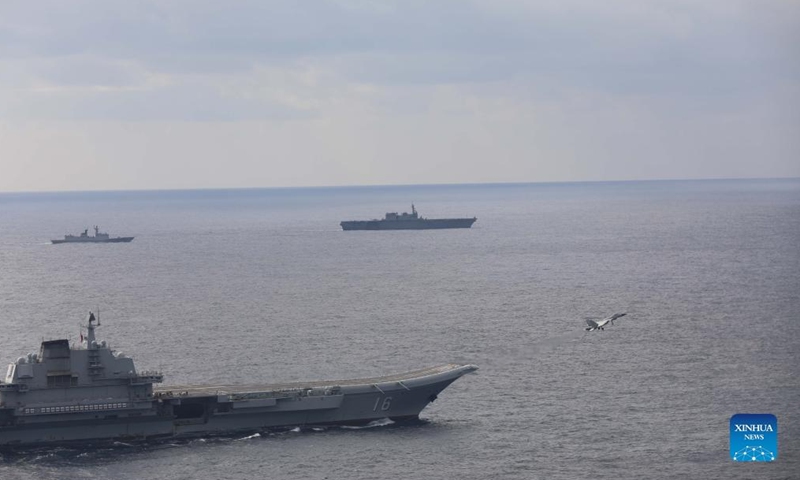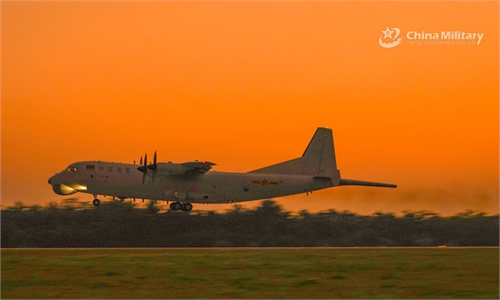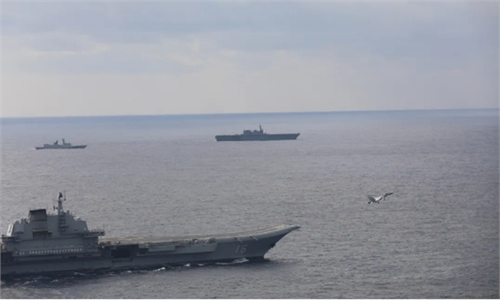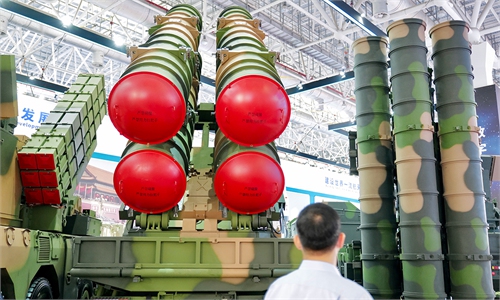UPDATE: Aircraft carrier Liaoning hosts fighter jet drills in Philippine Sea, ‘displays confidence’

Undated file photo shows the Chinese navy's Liaoning aircraft-carrier formation conducting open-sea combat training.Photo:Xinhua
The aircraft carrier Liaoning of the Chinese People's Liberation Army (PLA) Navy hosted fighter jet drills in the Philippine Sea on Tuesday, Japan's defense ministry said on Wednesday, soon after the PLA Navy announced the carrier group sailed into the West Pacific for a routine, realistic combat far sea training mission.
By hosting fighter jet drills right in front of monitoring by Japanese and potentially US forces, the PLA Navy showed its confidence amid its rising capabilities, experts said on Thursday.
A total of seven PLA Navy vessels, namely the aircraft carrier Liaoning, the Type 052D guided missile destroyers Xining, Urumqi and Chengdu, the Type 052C guided missile destroyer Zhengzhou, the Type 054A guided missile frigate Xiangtan and the Type 901 comprehensive supply ship Hulunhu, were spotted on Tuesday sailing in the Philippines Sea, south to Japan and east to the island of Taiwan, according to a press release by Japan's Ministry of Defense Joint Staff on Wednesday.
J-15 carrier-based fighter jets and Z-18 early warning helicopter conducted takeoff and landing from the aircraft carrier Liaoning during the voyage, the Japanese press release said. Photos attached to the release show that the J-15 fighter jets carried missiles under their wings.
Japan Maritime Self-Defense Force dispatched its de facto aircraft carrier, the Izumo, to gather intelligence and monitor the activities of the Chinese vessels, the press release said, noting that Japan also sortied fighter jets to "deal with" the J-15s.
The Japanese press release came after Senior Captain Gao Xiucheng, a spokesperson of the PLA Navy said on Tuesday that the PLA Navy sent the Liaoning aircraft carrier group to conduct realistic combat training in the far sea of the West Pacific.
The exercise is a routine one organized according to the annual schedule and is aimed at boosting the Navy's capabilities to carry out its duties, Gao said, noting that the voyage is in line with related international law and practice and is not targeted at another party.
Analysts said that far sea exercises have already become routine for the Liaoning, as the PLA Navy is making strides to become a deep-blue navy.
In addition to the Japanese de facto aircraft carrier Izumo, the US Navy's Abraham Lincoln carrier strike group was also operating in the Philippines Sea at least as of Monday, according to the Fleet and Marine Tracker by the news website of the US Naval Institute.
It is possible that the Chinese, Japanese and US aircraft carriers are in close vicinity with each other, Song Zhongping, a Chinese military expert and TV commentator, told the Global Times on Thursday.
While the aircraft carrier Abraham Lincoln itself will not likely show up, other US vessels in its strike group could come and make close-in reconnaissance attempts, Song said.
It is almost certain that Japanese and US warships and warplanes will conduct close-in reconnaissance attempts and make some provocative moves on the Chinese flotilla, so the Chinese vessels and vessel-based aircraft must have been well prepared to confidently deal with them, experts said.
Dealing with these interferences is also part of realistic combat training, Song said.
When Japan's Ministry of Defense Joint Staff first reported the Liaoning carrier group on Monday, it said the group included the Type 055 large guided missile destroyer Nanchang. But the vessel was missing in Wednesday's report.
Song said that the Type 055, as the most powerful escort in the carrier group, could be on a vigilance task some distance away from the group.
Foreign media reports speculated last month that the Type 055 is equipped with anti-ship hypersonic ballistic missiles that can keep US carrier strike groups at a distance.




